Class 9: Maths Chapter 10 solutions. Complete Class 9 Maths Chapter 10 Notes.
Contents
RD Sharma Solutions for Class 9 Maths Chapter 10–Congruent Triangles
RD Sharma 9th Maths Chapter 10, Class 9 Maths Chapter 10 solutions
Exercise 10.1
Question 1: In figure, the sides BA and CA have been produced such that BA = AD and CA = AE. Prove that segment DE ∥ BC.

Solution:
Sides BA and CA have been produced such that BA = AD and CA = AE.
To prove: DE ∥ BC
Consider △ BAC and △DAE,
BA = AD and CA= AE (Given)
∠BAC = ∠DAE (vertically opposite angles)
By SAS congruence criterion, we have
△ BAC ≃ △ DAE
We know, corresponding parts of congruent triangles are equal
So, BC = DE and ∠DEA = ∠BCA, ∠EDA = ∠CBA
Now, DE and BC are two lines intersected by a transversal DB s.t.
∠DEA=∠BCA (alternate angles are equal)
Therefore, DE ∥ BC. Proved.
Question 2: In a PQR, if PQ = QR and L, M and N are the mid-points of the sides PQ, QR and RP respectively. Prove that LN = MN.
Solution:
Draw a figure based on given instruction,

In △PQR, PQ = QR and L, M, N are midpoints of the sides PQ, QP and RP respectively (Given)
To prove : LN = MN
As two sides of the triangle are equal, so △ PQR is an isosceles triangle
PQ = QR and ∠QPR = ∠QRP ……. (i)
Also, L and M are midpoints of PQ and QR respectively
PL = LQ = QM = MR = QR/2
Now, consider Δ LPN and Δ MRN,
LP = MR
∠LPN = ∠MRN [From (i)]
∠QPR = ∠LPN and ∠QRP = ∠MRN
PN = NR [N is midpoint of PR]
By SAS congruence criterion,
Δ LPN ≃ Δ MRN
We know, corresponding parts of congruent triangles are equal.
So LN = MN
Proved.
Question 3: In figure, PQRS is a square and SRT is an equilateral triangle. Prove that
(i) PT = QT (ii) ∠ TQR = 150
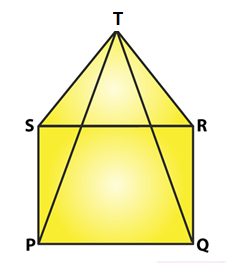
Solution:
Given: PQRS is a square and SRT is an equilateral triangle.
To prove:
(i) PT =QT and (ii) ∠ TQR =15°
Now,
PQRS is a square:
PQ = QR = RS = SP …… (i)
And ∠ SPQ = ∠ PQR = ∠ QRS = ∠ RSP = 90o
Also, △ SRT is an equilateral triangle:
SR = RT = TS …….(ii)
And ∠ TSR = ∠ SRT = ∠ RTS = 60°
From (i) and (ii)
PQ = QR = SP = SR = RT = TS ……(iii)
From figure,
∠TSP = ∠TSR + ∠ RSP = 60° + 90° = 150° and
∠TRQ = ∠TRS + ∠ SRQ = 60° + 90° = 150°
=> ∠ TSP = ∠ TRQ = 1500 ………………… (iv)
By SAS congruence criterion, Δ TSP ≃ Δ TRQ
We know, corresponding parts of congruent triangles are equal
So, PT = QT
Proved part (i).
Now, consider Δ TQR.
QR = TR [From (iii)]
Δ TQR is an isosceles triangle.
∠ QTR = ∠ TQR [angles opposite to equal sides]
Sum of angles in a triangle = 180∘
=> ∠QTR + ∠ TQR + ∠TRQ = 180°
=> 2 ∠ TQR + 150° = 180° [From (iv)]
=> 2 ∠ TQR = 30°
=> ∠ TQR = 150
Hence proved part (ii).
Question 4: Prove that the medians of an equilateral triangle are equal.
Solution:
Consider an equilateral △ABC, and Let D, E, F are midpoints of BC, CA and AB.
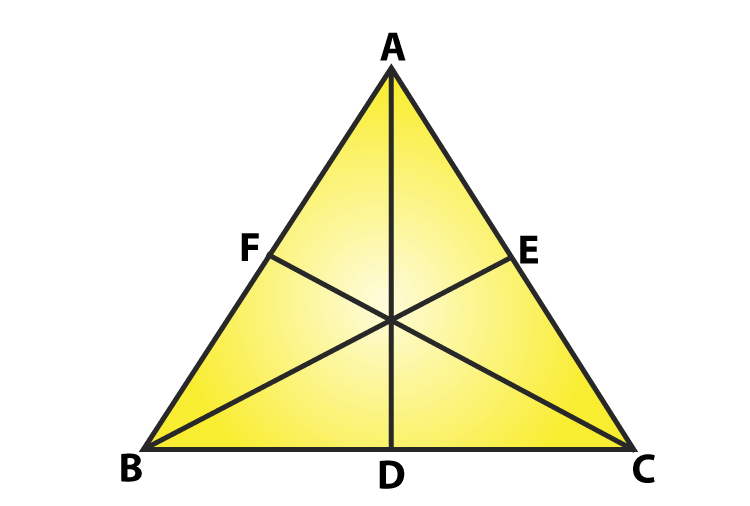
Here, AD, BE and CF are medians of △ABC.
Now,
D is midpoint of BC => BD = DC
Similarly, CE = EA and AF = FB
Since ΔABC is an equilateral triangle
AB = BC = CA …..(i)
BD = DC = CE = EA = AF = FB …………(ii)
And also, ∠ ABC = ∠ BCA = ∠ CAB = 60° ……….(iii)
Consider Δ ABD and Δ BCE
AB = BC [From (i)]
BD = CE [From (ii)]
∠ ABD = ∠ BCE [From (iii)]
By SAS congruence criterion,
Δ ABD ≃ Δ BCE
=> AD = BE ……..(iv)[Corresponding parts of congruent triangles are equal in measure]
Now, consider Δ BCE and Δ CAF,
BC = CA [From (i)]
∠ BCE = ∠ CAF [From (iii)]
CE = AF [From (ii)]
By SAS congruence criterion,
Δ BCE ≃ Δ CAF
=> BE = CF …………..(v)[Corresponding parts of congruent triangles are equal]
From (iv) and (v), we have
AD = BE = CF
Median AD = Median BE = Median CF
The medians of an equilateral triangle are equal.
Hence proved
Question 5: In a Δ ABC, if ∠A = 120° and AB = AC. Find ∠B and ∠C.
Solution:
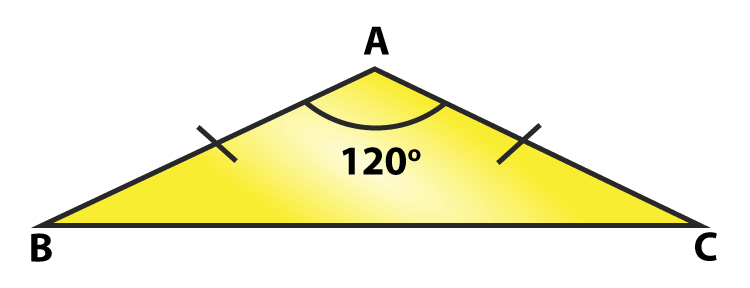
To find: ∠ B and ∠ C.
Here, Δ ABC is an isosceles triangle since AB = AC
∠ B = ∠ C ……… (i)[Angles opposite to equal sides are equal]
We know, sum of angles in a triangle = 180°
∠ A + ∠ B + ∠ C = 180°
∠ A + ∠ B + ∠ B= 180° (using (i)
1200 + 2∠B = 1800
2∠B = 1800 – 1200 = 600
∠ B = 30o
Therefore, ∠ B = ∠ C = 30∘
Question 6: In a Δ ABC, if AB = AC and ∠ B = 70°, find ∠ A.
Solution:
Given: In a Δ ABC, AB = AC and ∠B = 70°
∠ B = ∠ C [Angles opposite to equal sides are equal]
Therefore, ∠ B = ∠ C = 70∘
Sum of angles in a triangle = 180∘
∠ A + ∠ B + ∠ C = 180o
∠ A + 70o + 70o = 180o
∠ A = 180o – 140o
∠ A = 40o
Exercise 10.2
Question 1: In figure, it is given that RT = TS, ∠ 1 = 2 ∠ 2 and ∠4 = 2(∠3). Prove that ΔRBT ≅ ΔSAT.
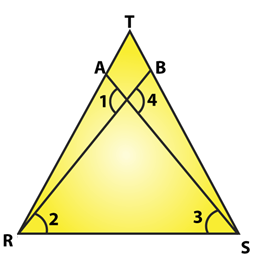
Solution:
In the figure,
RT = TS ……(i)
∠ 1 = 2 ∠ 2 ……(ii)
And ∠ 4 = 2 ∠ 3 ……(iii)
To prove: ΔRBT ≅ ΔSAT
Let the point of intersection RB and SA be denoted by O
∠ AOR = ∠ BOS [Vertically opposite angles]
or ∠ 1 = ∠ 4
2 ∠ 2 = 2 ∠ 3 [From (ii) and (iii)]
or ∠ 2 = ∠ 3 ……(iv)
Now in Δ TRS, we have RT = TS
=> Δ TRS is an isosceles triangle
∠ TRS = ∠ TSR ……(v)
But, ∠ TRS = ∠ TRB + ∠ 2 ……(vi)
∠ TSR = ∠ TSA + ∠ 3 ……(vii)
Putting (vi) and (vii) in (v) we get
∠ TRB + ∠ 2 = ∠ TSA + ∠ 3
=> ∠ TRB = ∠ TSA [From (iv)]
Consider Δ RBT and Δ SAT
RT = ST [From (i)]
∠ TRB = ∠ TSA [From (iv)]
By ASA criterion of congruence, we have
Δ RBT ≅ Δ SAT
Question 2: Two lines AB and CD intersect at O such that BC is equal and parallel to AD. Prove that the lines AB and CD bisect at O.
Solution: Lines AB and CD Intersect at O

Such that BC ∥ AD and
BC = AD …….(i)
To prove : AB and CD bisect at O.
First we have to prove that Δ AOD ≅ Δ BOC
∠OCB =∠ODA [AD||BC and CD is transversal]
AD = BC [from (i)]
∠OBC = ∠OAD [AD||BC and AB is transversal]
By ASA Criterion:
Δ AOD ≅ Δ BOC
OA = OB and OD = OC (By c.p.c.t.)
Therefore, AB and CD bisect each other at O.
Hence Proved.
Question 3: BD and CE are bisectors of ∠ B and ∠ C of an isosceles Δ ABC with AB = AC. Prove that BD = CE.
Solution:
Δ ABC is isosceles with AB = AC and BD and CE are bisectors of ∠ B and ∠ C We have to prove BD = CE. (Given)
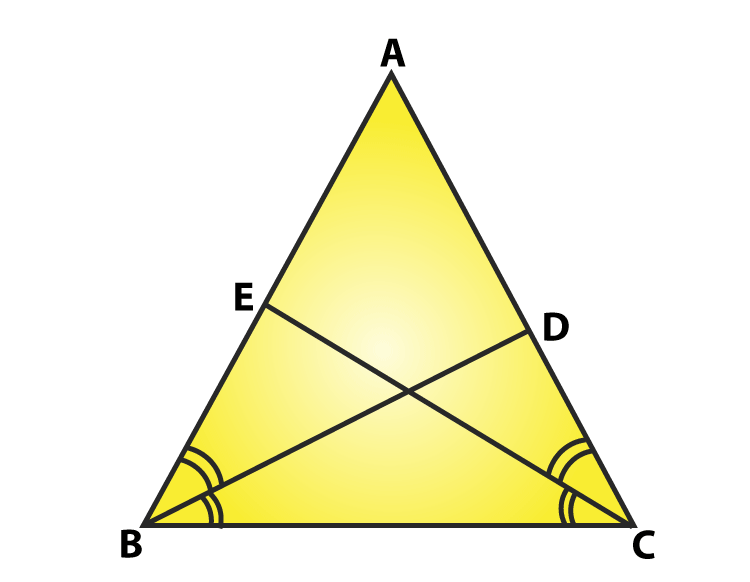
Since AB = AC
=> ∠ABC = ∠ACB ……(i)[Angles opposite to equal sides are equal]
Since BD and CE are bisectors of ∠ B and ∠ C
∠ ABD = ∠ DBC = ∠ BCE = ECA = ∠B/2 = ∠C/2 …(ii)
Now, Consider Δ EBC = Δ DCB
∠ EBC = ∠ DCB [From (i)]
BC = BC [Common side]
∠ BCE = ∠ CBD [From (ii)]
By ASA congruence criterion, Δ EBC ≅ Δ DCB
Since corresponding parts of congruent triangles are equal.
=> CE = BD
or, BD = CE
Hence proved.
Exercise 10.3
Question 1: In two right triangles one side an acute angle of one are equal to the corresponding side and angle of the other. Prove that the triangles are congruent.
Solution:
In two right triangles one side and acute angle of one are equal to the corresponding side and angles of the other. (Given)
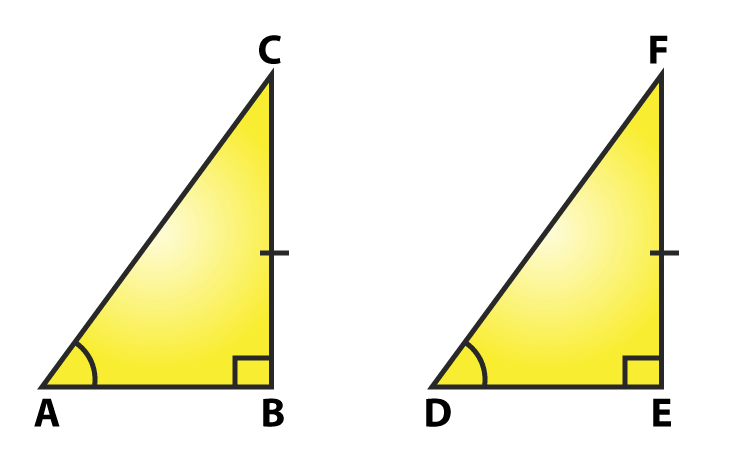
To prove: Both the triangles are congruent.
Consider two right triangles such that
∠ B = ∠ E = 90o …….(i)
AB = DE …….(ii)
∠ C = ∠ F ……(iii)
Here we have two right triangles, △ ABC and △ DEF
From (i), (ii) and (iii),
By AAS congruence criterion, we have Δ ABC ≅ Δ DEF
Both the triangles are congruent. Hence proved.
Question 2: If the bisector of the exterior vertical angle of a triangle be parallel to the base. Show that the triangle is isosceles.
Solution:
Let ABC be a triangle such that AD is the angular bisector of exterior vertical angle, ∠EAC and AD ∥ BC.
From figure,
∠1 = ∠2 [AD is a bisector of ∠ EAC]
∠1 = ∠3 [Corresponding angles]
and ∠2 = ∠4 [alternative angle]
From above, we have ∠3 = ∠4
This implies, AB = AC
Two sides AB and AC are equal.
=> Δ ABC is an isosceles triangle.
Question 3: In an isosceles triangle, if the vertex angle is twice the sum of the base angles, calculate the angles of the triangle.
Solution:
Let Δ ABC be isosceles where AB = AC and ∠ B = ∠ C
Given: Vertex angle A is twice the sum of the base angles B and C. i.e., ∠ A = 2(∠ B + ∠ C)
∠ A = 2(∠ B + ∠ B)
∠ A = 2(2 ∠ B)
∠ A = 4(∠ B)
Now, We know that sum of angles in a triangle =180°
∠ A + ∠ B + ∠ C =180°
4 ∠ B + ∠ B + ∠ B = 180°
6 ∠ B =180°
∠ B = 30°
Since, ∠ B = ∠ C
∠ B = ∠ C = 30°
And ∠ A = 4 ∠ B
∠ A = 4 x 30° = 120°
Therefore, angles of the given triangle are 30° and 30° and 120°.
Question 4: PQR is a triangle in which PQ = PR and is any point on the side PQ. Through S, a line is drawn parallel to QR and intersecting PR at T. Prove that PS = PT.
Solution: Given that PQR is a triangle such that PQ = PR and S is any point on the side PQ and ST ∥ QR.
To prove: PS = PT
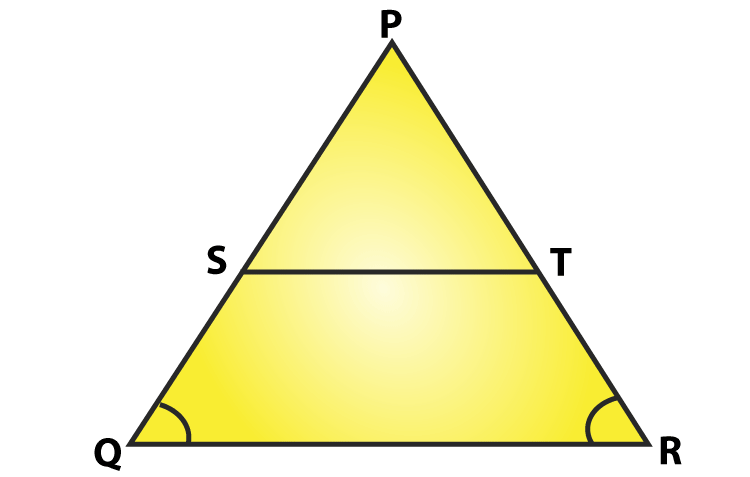
Since, PQ= PR, so △PQR is an isosceles triangle.
∠ PQR = ∠ PRQ
Now, ∠ PST = ∠ PQR and ∠ PTS = ∠ PRQ[Corresponding angles as ST parallel to QR]
Since, ∠ PQR = ∠ PRQ
∠ PST = ∠ PTS
In Δ PST,
∠ PST = ∠ PTS
Δ PST is an isosceles triangle.
Therefore, PS = PT.
Hence proved.
Exercise 10.4
Question 1: In figure, It is given that AB = CD and AD = BC. Prove that ΔADC ≅ ΔCBA.
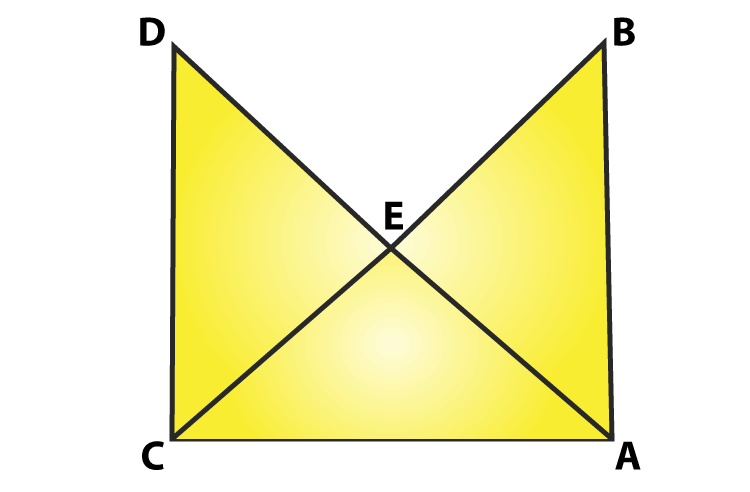
Solution:
From figure, AB = CD and AD = BC.
To prove: ΔADC ≅ ΔCBA
Consider Δ ADC and Δ CBA.
AB = CD [Given]
BC = AD [Given]
And AC = AC [Common side]
So, by SSS congruence criterion, we have
ΔADC≅ΔCBA
Hence proved.
Question 2: In a Δ PQR, if PQ = QR and L, M and N are the mid-points of the sides PQ, QR and RP respectively. Prove that LN = MN.
Solution:
Given: In Δ PQR, PQ = QR and L, M and N are the mid-points of the sides PQ, QR and RP respectively
To prove: LN = MN
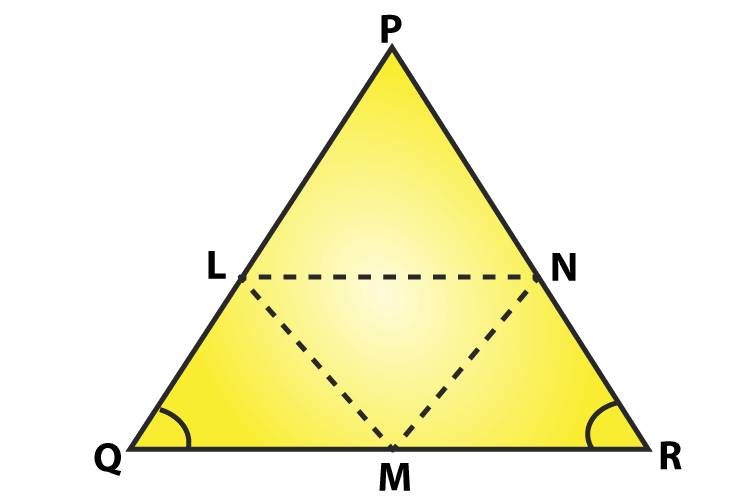
Join L and M, M and N, N and L
We have PL = LQ, QM = MR and RN = NP[Since, L, M and N are mid-points of PQ, QR and RP respectively]
And also PQ = QR
PL = LQ = QM = MR = PN = LR …….(i)[ Using mid-point theorem]
MN ∥ PQ and MN = PQ/2
MN = PL = LQ ……(ii)
Similarly, we have
LN ∥ QR and LN = (1/2)QR
LN = QM = MR ……(iii)
From equation (i), (ii) and (iii), we have
PL = LQ = QM = MR = MN = LN
This implies, LN = MN
Hence Proved.
Exercise 10.5
Question 1: ABC is a triangle and D is the mid-point of BC. The perpendiculars from D to AB and AC are equal. Prove that the triangle is isosceles.
Solution:
Given: D is the midpoint of BC and PD = DQ in a triangle ABC.
To prove: ABC is isosceles triangle.
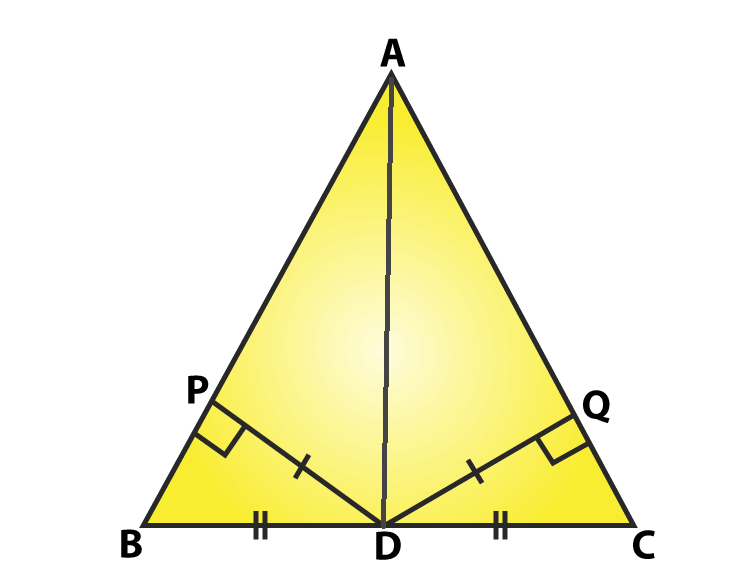
In △BDP and △CDQ
PD = QD (Given)
BD = DC (D is mid-point)
∠BPD = ∠CQD = 90o
By RHS Criterion: △BDP ≅ △CDQ
BP = CQ … (i) (By CPCT)
In △APD and △AQD
PD = QD (given)
AD = AD (common)
APD = AQD = 90 o
By RHS Criterion: △APD ≅ △AQD
So, PA = QA … (ii) (By CPCT)
Adding (i) and (ii)
BP + PA = CQ + QA
AB = AC
Two sides of the triangle are equal, so ABC is an isosceles.
Question 2: ABC is a triangle in which BE and CF are, respectively, the perpendiculars to the sides AC and AB. If BE = CF, prove that Δ ABC is isosceles
Solution:
ABC is a triangle in which BE and CF are perpendicular to the sides AC and AB respectively s.t. BE = CF.
To prove: Δ ABC is isosceles
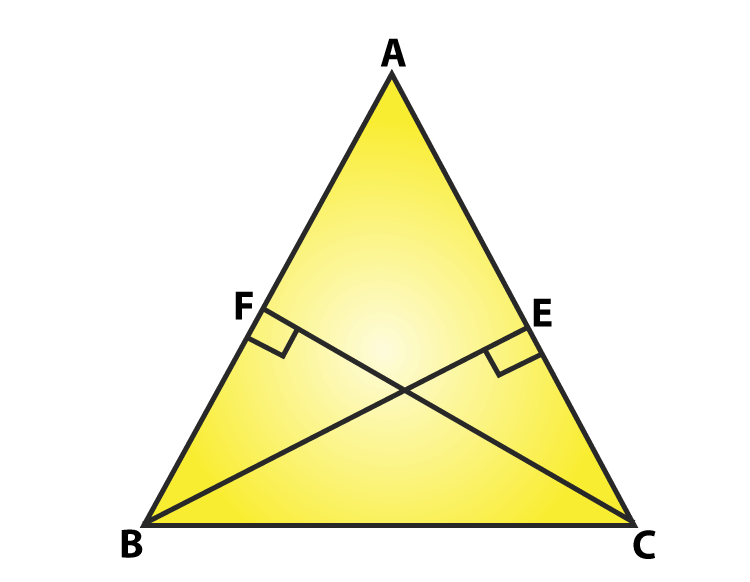
In Δ BCF and Δ CBE,
∠ BFC = CEB = 90o [Given]
BC = CB [Common side]
And CF = BE [Given]
By RHS congruence criterion: ΔBFC ≅ ΔCEB
So, ∠ FBC = ∠ EBC [By CPCT]
=>∠ ABC = ∠ ACB
AC = AB [Opposite sides to equal angles are equal in a triangle]
Two sides of triangle ABC are equal.
Therefore, Δ ABC is isosceles. Hence Proved.
Question 3: If perpendiculars from any point within an angle on its arms are congruent. Prove that it lies on the bisector of that angle.
Solution:
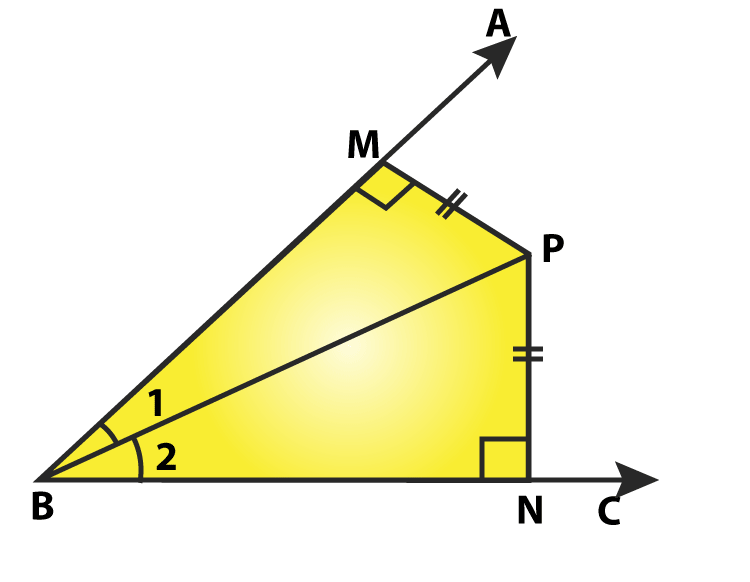
Consider an angle ABC and BP be one of the arm within the angle.
Draw perpendiculars PN and PM on the arms BC and BA.
In Δ BPM and Δ BPN,
∠ BMP = ∠ BNP = 90° [given]
BP = BP [Common side]
MP = NP [given]
By RHS congruence criterion: ΔBPM≅ΔBPN
So, ∠ MBP = ∠ NBP [ By CPCT]
BP is the angular bisector of ∠ABC.
Hence proved
Exercise 10.6 Page No: 10.66
Question 1: In Δ ABC, if ∠ A = 40° and ∠ B = 60°. Determine the longest and shortest sides of the triangle.
Solution: In Δ ABC, ∠ A = 40° and ∠ B = 60°
We know, sum of angles in a triangle = 180°
∠ A + ∠ B + ∠ C = 180°
40° + 60° + ∠ C = 180°
∠ C = 180° – 100° = 80°
∠ C = 80°
Now, 40° < 60° < 80°
=> ∠ A < ∠ B < ∠ C
=> ∠ C is greater angle and ∠ A is smaller angle.
Now, ∠ A < ∠ B < ∠ C
We know, side opposite to greater angle is larger and side opposite to smaller angle is smaller.
Therefore, BC < AC < AB
AB is longest and BC is shortest side.
Question 2: In a Δ ABC, if ∠ B = ∠ C = 45°, which is the longest side?
Solution: In Δ ABC, ∠ B = ∠ C = 45°
Sum of angles in a triangle = 180°
∠ A + ∠ B + ∠ C = 180°
∠ A + 45° + 45° = 180°
∠ A = 180° – (45° + 45°) = 180° – 90° = 90°
∠ A = 90°
=> ∠ B = ∠ C < ∠ A
Therefore, BC is the longest side.
Question 3: In Δ ABC, side AB is produced to D so that BD = BC. If ∠ B = 60° and ∠ A = 70°.
Prove that: (i) AD > CD (ii) AD > AC
Solution: In Δ ABC, side AB is produced to D so that BD = BC.
∠ B = 60°, and ∠ A = 70°

To prove: (i) AD > CD (ii) AD > AC
Construction: Join C and D
We know, sum of angles in a triangle = 180°
∠ A + ∠ B + ∠ C = 180°
70° + 60° + ∠ C = 180°
∠ C = 180° – (130°) = 50°
∠ C = 50°
∠ ACB = 50° ……(i)
And also in Δ BDC
∠ DBC =180° – ∠ ABC = 180 – 60° = 120°[∠DBA is a straight line]
and BD = BC [given]
∠ BCD = ∠ BDC [Angles opposite to equal sides are equal]
Sum of angles in a triangle =180°
∠ DBC + ∠ BCD + ∠ BDC = 180°
120° + ∠ BCD + ∠ BCD = 180°
120° + 2∠ BCD = 180°
2∠ BCD = 180° – 120° = 60°
∠ BCD = 30°
∠ BCD = ∠ BDC = 30° ….(ii)
Now, consider Δ ADC.
∠ DAC = 70° [given]
∠ ADC = 30° [From (ii)]
∠ ACD = ∠ ACB+ ∠ BCD = 50° + 30° = 80° [From (i) and (ii)]
Now, ∠ ADC < ∠ DAC < ∠ ACD
AC < DC < AD[Side opposite to greater angle is longer and smaller angle is smaller]
AD > CD and AD > AC
Hence proved.
Question 4: Is it possible to draw a triangle with sides of length 2 cm, 3 cm and 7 cm?
Solution:
Lengths of sides are 2 cm, 3 cm and 7 cm.
A triangle can be drawn only when the sum of any two sides is greater than the third side.
So, let’s check the rule.
2 + 3 ≯ 7 or 2 + 3 < 7
2 + 7 > 3
and 3 + 7 > 2
Here 2 + 3 ≯ 7
So, the triangle does not exit.
Exercise VSAQs
Question 1: In two congruent triangles ABC and DEF, if AB = DE and BC = EF. Name the pairs of equal angles.
Solution:
In two congruent triangles ABC and DEF, if AB = DE and BC = EF, then
∠A = ∠D, ∠B = ∠ E and ∠ C = ∠F
Question 2: In two triangles ABC and DEF, it is given that ∠A = ∠D, ∠B = ∠ E and ∠ C = ∠F. Are the two triangles necessarily congruent?
Solution: No.
Reason: Two triangles are not necessarily congruent, because we know only angle-angle-angle (AAA) criterion. This criterion can produce similar but not congruent triangles.
Question 3: If ABC and DEF are two triangles such that AC = 2.5 cm, BC = 5 cm, C = 75o, DE = 2.5 cm, DF = 5 cm and D = 75o. Are two triangles congruent?
Solution: Yes.
Reason: Given triangles are congruent as AC = DE = 2.5 cm, BC = DF = 5 cm and
∠D = ∠C = 75o.
By SAS theorem triangle ABC is congruent to triangle EDF.
Question 4: In two triangles ABC and ADC, if AB = AD and BC = CD. Are they congruent?
Solution: Yes.
Reason: Given triangles are congruent as
AB = AD
BC = CD and
AC [ common side]
By SSS theorem triangle ABC is congruent to triangle ADC.
Question 5: In triangles ABC and CDE, if AC = CE, BC = CD, ∠A = 60o, ∠C = 30 o and ∠D = 90 o. Are two triangles congruent?
Solution: Yes.
Reason: Given triangles are congruent
Here AC = CE
BC = CD
∠B = ∠D = 90°
By SSA criteria triangle ABC is congruent to triangle CDE.
Question 6: ABC is an isosceles triangle in which AB = AC. BE and CF are its two medians. Show that BE = CF.
Solution: ABC is an isosceles triangle (given)
AB = AC (given)
BE and CF are two medians (given)
To prove: BE = CF
In △CFB and △BEC
CE = BF (Since, AC = AB = AC/2 = AB/2 = CE = BF)
BC = BC (Common)
∠ECB = ∠FBC (Angle opposite to equal sides are equal)
By SAS theorem: △CFB ≅ △BEC
So, BE = CF (By c.p.c.t)
RD Sharma Solutions for Class 9 Maths Chapter 10: Download PDF
RD Sharma Solutions for Class 9 Maths Chapter 10–Congruent Triangles
Download PDF: RD Sharma Solutions for Class 9 Maths Chapter 10–Congruent Triangles PDF
Chapterwise RD Sharma Solutions for Class 9 Maths :
- Chapter 1–Number System
- Chapter 2–Exponents of Real Numbers
- Chapter 3–Rationalisation
- Chapter 4–Algebraic Identities
- Chapter 5–Factorization of Algebraic Expressions
- Chapter 6–Factorization Of Polynomials
- Chapter 7–Introduction to Euclid’s Geometry
- Chapter 8–Lines and Angles
- Chapter 9–Triangle and its Angles
- Chapter 10–Congruent Triangles
- Chapter 11–Coordinate Geometry
- Chapter 12–Heron’s Formula
- Chapter 13–Linear Equations in Two Variables
- Chapter 14–Quadrilaterals
- Chapter 15–Area of Parallelograms and Triangles
- Chapter 16–Circles
- Chapter 17–Construction
- Chapter 18–Surface Area and Volume of Cuboid and Cube
- Chapter 19–Surface Area and Volume of A Right Circular Cylinder
- Chapter 20–Surface Area and Volume of A Right Circular Cone
- Chapter 21–Surface Area And Volume Of Sphere
- Chapter 22–Tabular Representation of Statistical Data
- Chapter 23–Graphical Representation of Statistical Data
- Chapter 24–Measure of Central Tendency
- Chapter 25–Probability
About RD Sharma
RD Sharma isn’t the kind of author you’d bump into at lit fests. But his bestselling books have helped many CBSE students lose their dread of maths. Sunday Times profiles the tutor turned internet star
He dreams of algorithms that would give most people nightmares. And, spends every waking hour thinking of ways to explain concepts like ‘series solution of linear differential equations’. Meet Dr Ravi Dutt Sharma — mathematics teacher and author of 25 reference books — whose name evokes as much awe as the subject he teaches. And though students have used his thick tomes for the last 31 years to ace the dreaded maths exam, it’s only recently that a spoof video turned the tutor into a YouTube star.
R D Sharma had a good laugh but said he shared little with his on-screen persona except for the love for maths. “I like to spend all my time thinking and writing about maths problems. I find it relaxing,” he says. When he is not writing books explaining mathematical concepts for classes 6 to 12 and engineering students, Sharma is busy dispensing his duty as vice-principal and head of department of science and humanities at Delhi government’s Guru Nanak Dev Institute of Technology.
